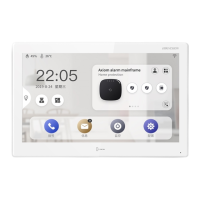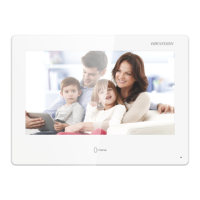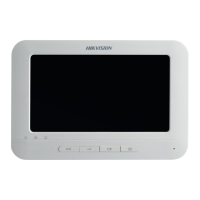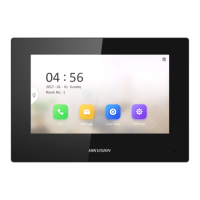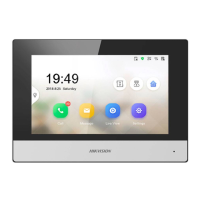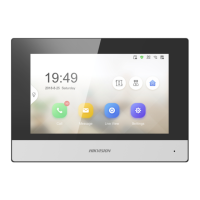Do you have a question about the HIKVISION DS-KH9510-WTE1(B) and is the answer not in the manual?
| Model | DS-KH9510-WTE1(B) |
|---|---|
| Category | Intercom System |
| ROM | 8 GB |
| RAM | 1 GB |
| Video Standard | H.264 |
| WDR | Yes |
| Audio Input | Built-in microphone |
| Ethernet | 10/100 Mbps |
| Network Interface | RJ45 |
| RS-485 | Yes |
| Power Supply | DC 12V |
| Working Temperature | -10°C to +55°C |
| Installation | Wall-mounted |
| Weight | 1.5 kg |
| Display Screen | 10.1 inch |
| Operating System | Linux |
| Camera | 2MP |
| Audio Output | Built-in speaker |
| Audio Quality | High quality |
| Network | Yes |
| Network Protocol | TCP/IP |
| Wi-Fi | IEEE 802.11 b/g/n |
| TF Card | Support |
| Working Humidity | 10% to 90% |
| Resolution | 1280 x 800 |
Provides instructions for using and managing the product, and where to find the latest version.
Lists Hikvision's trademarks and logos, and acknowledges other companies' trademarks.
Outlines liability limitations, warranty disclaimers, and user responsibilities for product use.
Explains how personal data is collected and processed, emphasizing privacy by design principles.
Defines symbols used in the document to indicate danger, caution, and notes for user guidance.
Details critical safety warnings for electrical operations, power usage, and device handling.
Lists precautions for physical handling, environmental conditions, and avoiding device damage.
Covers FCC compliance, interference guidelines, and measures to correct interference.
States the two conditions for FCC compliance: no harmful interference and acceptance of received interference.
Declares product compliance with European directives (EMC, RE, RoHS) and waste disposal.
Confirms compliance with Industry Canada standards and license-exempt RSS rules.
Introduces the manual and provides information on obtaining the latest version and related software.
Guides through the initial activation process, including creating a password for the device.
Outlines the initial setup wizard, including language, password reset, and network settings.
Explains how to wake the device from standby mode and unlock it using a gesture password.
Covers essential initial configurations like network, room number, and linked devices.
Details how to configure network connection, IP address, subnet mask, and gateway.
Explains how to set network parameters for linked devices like door stations.
Provides steps to add external cameras to the indoor station for video monitoring.
Details how to configure zone types, alarm types, and delay times for security.
Explains how to configure different arming modes (stay, away, sleeping, custom) for security zones.
Covers managing admin, operation, and gesture passwords for security.
Guides on resetting the admin password using reserved email or security questions.
Explains how to set and manage unlock, duress, and arm/disarm passwords.
Explains how to synchronize the device's system time, including NTP settings.
Covers configuring ringtones, ring duration, call forwarding, and volume adjustments.
Guides on adding and uninstalling third-party applications on the device.
Provides steps for adding third-party applications via download address and installation type.
Explains how to remove third-party applications from the device.
Details how to configure and control connected output devices (relays) and their display.
Allows enabling shortcuts for common functions like Call Elevator, SOS, and Arm/Disarm.
Guides on restoring the device to its default factory settings.
Explains how to check for and perform system software upgrades for the indoor station.
Describes how to manually or automatically reboot the device.
Covers setting up security questions and email for admin password recovery.
Provides access to various system configurations like language and display settings.
Allows changing the system display language.
Allows configuring settings to suppress notifications or calls during specific times.
Configures the display to fit the screen, potentially enabling horizontal mode.
Guides on activating the indoor station remotely using client software.
Covers managing devices, including activation, adding, editing, and deleting.
Details the process of adding video intercom devices to the client software.
Explains how to modify the network settings of an already added device.
Allows configuration of various video intercom parameters like ringtone and speaking duration.
Provides access to configure device parameters remotely.
Accesses system-level remote configuration options like device information and maintenance.
Covers remote configuration of video intercom specific parameters.
Allows remote configuration of ring duration, live view duration, and call forwarding.
Allows remote configuration of zone types, alarm modes, and delays.
Guides on adding, deleting, and modifying IP camera configurations remotely.
Covers remote configuration of network settings.
Guides on configuring SIP server details for communication.
Covers managing user information, organizations, and access credentials.
Guides on creating, modifying, and deleting organizational structures.
Covers managing individual user profiles, including adding, editing, and issuing credentials.
Guides on adding new persons, including their details and credentials.
Provides a QR code to access the device communication matrix for port information.
Provides a QR code to access common serial port commands for devices.
